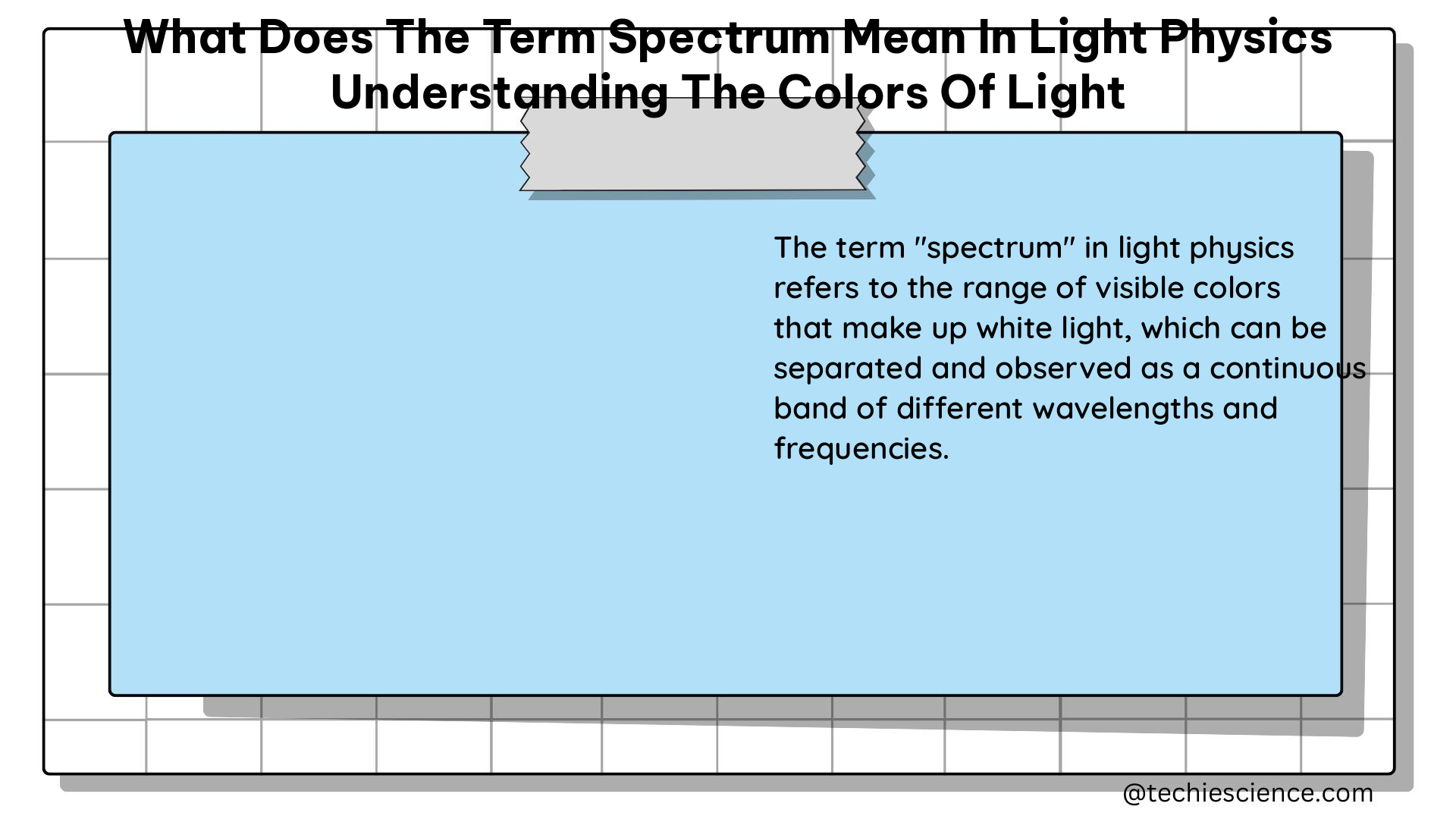The term “spectrum” in light physics refers to the range of colors observed when white light is dispersed through a prism or a plot of light intensity or power as a function of frequency or wavelength, also known as a spectral density plot. The visible light spectrum is the segment of the electromagnetic spectrum that the human eye can view, typically ranging from 380 to 700 nanometers in wavelength. This range of wavelengths corresponds to different colors, with violet having the shortest wavelength (around 380 nm) and red having the longest wavelength (around 700 nm).
The Theorem of Light Spectrum
The theorem of light spectrum states that white light is composed of different colors, and when it is passed through a prism, it is separated into the colors of the rainbow because each color refracts at a slightly different angle depending on the wavelength of the color. This is due to the fact that the speed of light varies depending on its wavelength, with shorter wavelengths (such as violet) traveling more slowly than longer wavelengths (such as red).
The Physics Formula for Light Spectrum

The formula for the wavelength of light is λ = c/f, where λ is the wavelength, c is the speed of light, and f is the frequency. This formula can be used to calculate the wavelength of a particular color of light given its frequency.
Examples of Light Spectrum
An example of light spectrum is the visible light spectrum, which ranges from 380 to 700 nanometers in wavelength and corresponds to different colors, with violet having the shortest wavelength and red having the longest wavelength.
Another example of light spectrum is absorption spectra, which are patterns of dark lines in the visible-light spectrum from the Sun and other stars that reveal the presence of certain elements in the atmosphere of the object. These patterns act like fingerprints for atoms and molecules, allowing scientists to identify the elements present in the atmosphere of the object.
Spectral signatures are also used in remote sensing applications to identify the characteristics of objects on Earth. For example, a graph of an object’s reflectance across a spectrum (called a spectral signature) can reveal the presence of certain elements or molecules in the object.
Numerical Problems Involving Light Spectrum
A problem involving light spectrum could be to calculate the wavelength of a particular color of light given its frequency. For example, if the frequency of violet light is 7.9 x 10^14 Hz, what is its wavelength? Using the formula λ = c/f, where c is the speed of light (3.0 x 10^8 m/s), we can calculate that the wavelength of violet light is 380 nm.
Figures Illustrating the Light Spectrum
A figure illustrating the visible light spectrum could show the different colors arranged in order of wavelength, with violet at one end and red at the other. This type of figure can help visualize the range of colors that make up the visible light spectrum.
Data Points for Light Spectrum
Data points for light spectrum could include the wavelengths and frequencies of different colors of light, as well as the intensity or power at each wavelength or frequency. This data can be used to create spectral density plots or other visualizations of the light spectrum.
Values and Measurements for Light Spectrum
Values and measurements for light spectrum could include the wavelengths and frequencies of different colors of light, as well as the speed of light and the refractive index of different materials. These values and measurements are important for understanding the behavior of light and how it interacts with different materials.
In summary, the term “spectrum” in light physics refers to the range of colors observed when white light is dispersed through a prism or a plot of light intensity or power as a function of frequency or wavelength. The visible light spectrum is a small portion of the full electromagnetic spectrum, and there are many other types of spectra that can be observed in light physics, such as absorption spectra and spectral signatures. Understanding the theorem, formulas, examples, numerical problems, figures, data points, and values and measurements related to light spectrum is crucial for a comprehensive understanding of the physics of light.
Reference:
- Understanding the Visible Light Spectrum
- Electromagnetic Spectrum
- Light Spectrum Explained
- Visible Light Spectrum
- What is Spectrum of Light?

The lambdageeks.com Core SME Team is a group of experienced subject matter experts from diverse scientific and technical fields including Physics, Chemistry, Technology,Electronics & Electrical Engineering, Automotive, Mechanical Engineering. Our team collaborates to create high-quality, well-researched articles on a wide range of science and technology topics for the lambdageeks.com website.
All Our Senior SME are having more than 7 Years of experience in the respective fields . They are either Working Industry Professionals or assocaited With different Universities. Refer Our Authors Page to get to know About our Core SMEs.